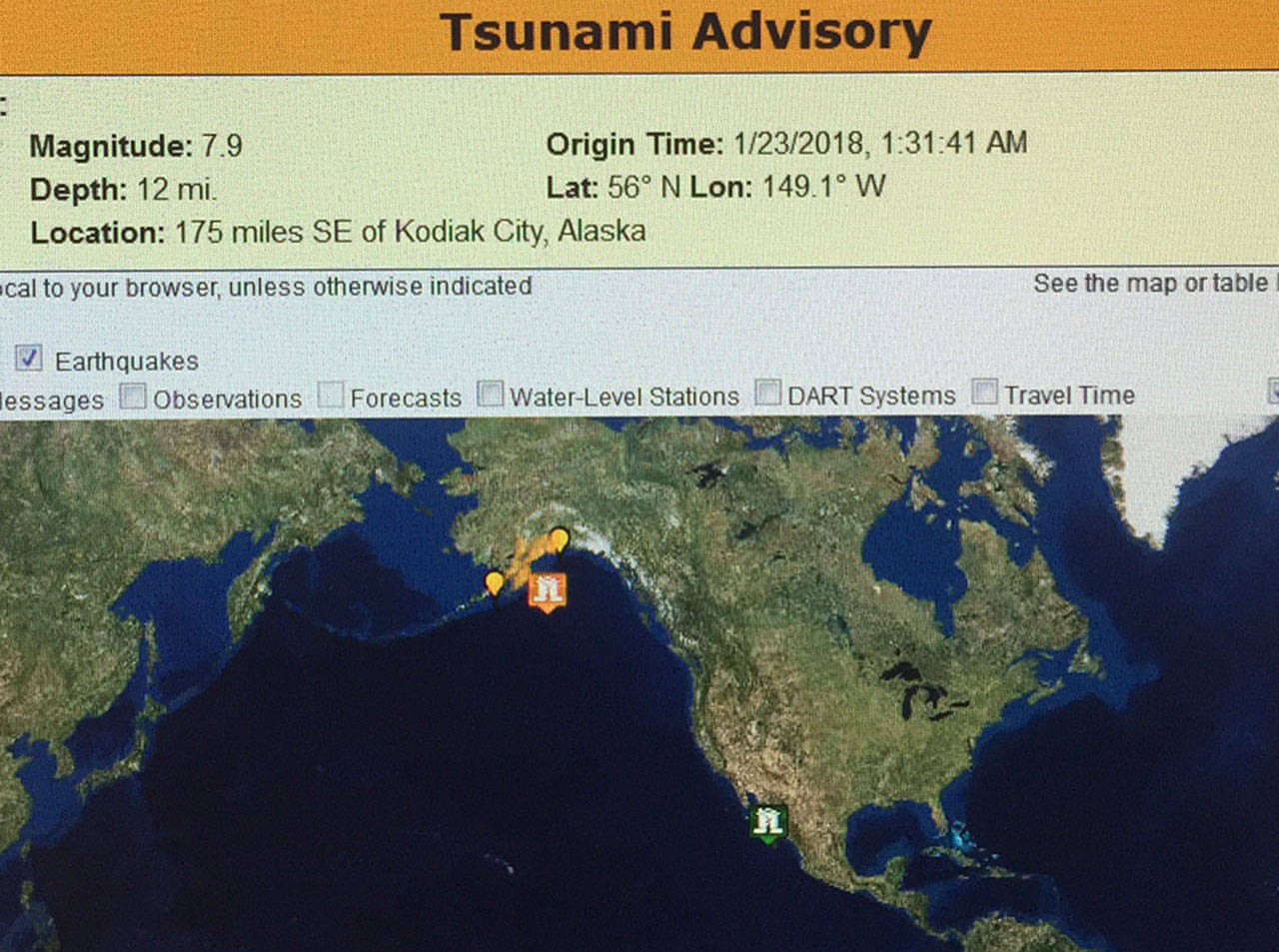A tsunami watch was issued for the coast of Washington early Tuesday morning, with the city of Ocean Shores and other communities manning command centers, after an earthquake of 7.9 magnitude rocked Alaska.
Local emergency officials began to prepare for a tsunami immediately after the quake, but they say they had trouble getting timely information because of what reportedly was the impact of the federal government shutdown on the National Oceanic and Atmospheric Administration (NOAA) — the agency that operates the Tsunami Warning Center.
The earthquake was recorded at 1:31 a.m. and located about 175 miles southeast of Kodiak City. It was recorded at a depth of 12 miles, according to the Tsunami Warning System.
The town of Adak, Alaska was evacuated after the first tsunami warning, but there were no reports of damage. The tsunami watch had included the coasts of Alaska, British Columbia, Washington and southern Oregon into California.
“We are still under a tsunami watch. The original 8.2 earthquake was downgraded to a 7.9, however, another 7.0 earthquake has impacted the Alaska area,” said Charles Wallace, Grays Harbor Emergency Management deputy director in a email alert at 3:36 a.m. “The National Tsunami Warning Center is evaluating impacts as they receive them and we should have more information from them shortly.”
The potential impact time was predicted to be at about 5 a.m. for a tsunami, but by then, the warning center had issued a new update of “no tsunami warning, watch or threat.”
Various news organizations reported NOAA’s website was not updated due to the shutdown that ended Monday night, and some other sites were not accessible. Newsweek.com reported that NOAA linked to a page that said: “The federal government is currently shut down. NOAA.gov and many associated websites are available while others remain live but not supported.”
In Ocean Shores, the Fire Department was alerted and a command team put in place, but no all-hazard warning sirens were sounded. Residents who had the All Hazard Weather ALERT Radios did receive the initial alert.
Ocean Shores Fire Lt. Corey Kuhl said the department’s tsunami alert was triggered at the same time the earthquake was first reported about 1:30 a.m., but getting further information “was a challenge due to government shutdown and some important sites not being up and running.”
The city of Ocean Shores then activated the Emergency Operations Center, and a Unified Incident Command Team was established under the command of the Fire Department, Kuhl said. The command team included the mayor, police chief and the Fire Department duty officers.
“Protocol was followed and preparations for possible evacuation took place,” Kuhl said, until the alert was cancelled about 4:30 a.m.
“This is a reminder to all citizens of the dangers and possibilities we deal with living at sea level on the coast, and it was a good opportunity for the Ocean Shores public safety team to practice the city’s emergency operations procedures,” Khul said of how the concern turned into be a real-time drill.
A tsunami watch is automatically declared by the Tsunami Warning Center for any earthquake magnitude 7.5 or larger (7.0 or larger in the Aleutian Islands) if the epicenter is in an area capable of generating a tsunami. Civil Defense is notified, and the local media is provided with public announcements. The center then waits for data from tide gauge stations to confirm whether or not a tsunami has been generated.
The center also requests reports on wave activity from tide-gauge stations near the earthquake epicenter. If the stations observe no tsunami activity, the tsunami watch is canceled. If the stations report that a tsunami has been generated, a tsunami warning is issued.
During a full warning, the emergency broadcast system alerts the public of the danger, and evacuation begins.
“During the Alaska tsunami event, Grays Harbor County Emergency Management was in communication with local police and fire departments, mayors, county officials as well as officials from NOAA and the National Weather Service in Seattle and State Emergency Management Division,” Wallace said.
“At no time was an activation of the coastal All Hazard Broadcast Sirens (AHAB), considered, due to the parameters of this particular event. This was true throughout the state. Remember, the AHAB Sirens are for outdoor notification only. All Hazard ALERT Weather Radios will supply the indoor notifications necessary to alert a sleeping family.”
Wallace said the warning Tuesday was a “wake-up call for many to begin preparing for an occurrence that can strike at any time.”
“Luckily, we were placed under a tsunami watch, which means there is a potential danger and to be alert and prepare for specific actions, (possibly move to high ground), should the conditions change,” Wallace said.
He advised the public to register to be notified of future events at the Grays Harbor County Emergency Notification System: http://www.co.grays-harbor.wa.us/departments/emergency_management
A future Alaska earthquake and tsunami event, Wallace warned, will be a “silent, no notice event. We will not feel an earthquake with the ground shaking providing the alert to wake people who are asleep, warning of potential tsunami waves approaching within 3-5 hours.
“Many people turn off their phone at night or keep it in another part of the house, preventing alert notice phone calls from reaching them. Without an All Hazard ALERT Weather Radio, or the alert phone call, many will remain asleep while the tsunami waves continue to approach, bearing down upon unsuspecting communities and the families living within.”



